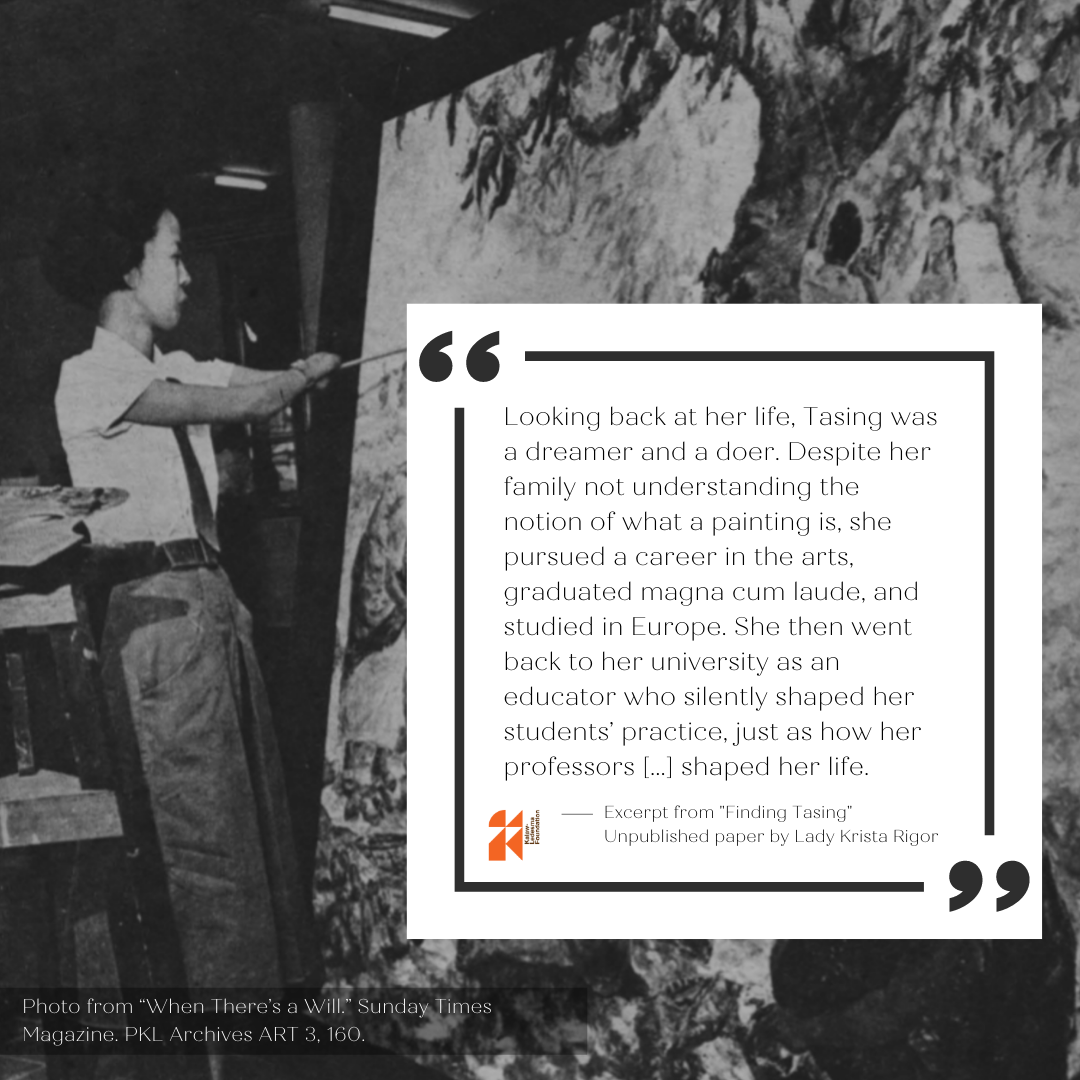I found Tasing when I went over the first three volumes of Purita Kalaw-Ledesma’s digitized scrapbooks, dense with news clippings and other ephemera about art. I had to physically visit the Kalaw-Ledesma Foundation Inc. (KLFI) in Makati to use their newly-fixed computer for researchers because at least here in the Philippines, the only way access the PDF version of the scrapbooks is via the CDs stored in their office. In Singapore, the softcopies are accessible without needing the disks after KLFI’s collaboration with National Gallery Singapore Research Centre in 2017.1
My only objective was to bring something or someone into light for my Art History paper. I surveyed the scrapbook pages with no direction on what or who to write about. The articles in the pages themselves have no structure but are not haphazardly picked. These were the artifacts at the time the art scene in the Philippines was developing, and this might be Purita’s way to make sense, like in artmaking, of the changing world. While there is a randomness in the content, the scrapbooks are arranged in chronological order. The first scrapbook contained articles from February 1948 to December 1949; second, June 1950 to October 1952; third, July 1952 to September 1953; and so on.
From time to time, I briefly paused my perusal to take note of something I sensed was worth exploring further. This process felt like going through someone’s belongings – like running through assortment of items from strangers in an ukay-ukay or vintage shop – checking if there could be something I can use. Given the limited time at the research center (Ms. Clavel, the admin personnel, even kindly extended her usual time to let me finish for the day), I had to stop at the third scrapbook and make do with my current notes.
Since I also had few weeks to work on this research, I had to decide what topic to devote myself to based on the notes that I gathered. I then revisited my mint green notebook, highlighted ideas for deliberation, and finally made my pick. Tasing was the
winner, hence this paper. She first appeared in the second scrapbook under the article Girl With Determination and also on the third volume where I jotted her name “Anastacia S. Mamuyak” in my notebook.
The uncovering, collecting, and coalescing of Tasing’s imprints call into mind Ingold’s notion of materiality. In a way, the archival data can be considered materials that commingled and formed a thing – Tasing, Tasing’s life, or my account of Tasing’s life – through a meshwork of the threads along Purita’s archives (and later, the interwebs) that led me to bits and pieces of her life. “People are things too,”2 according to Ingold, wherein a thing is a “gathering of materials in movement,3 a gathering together of the threads of life.”4 The anthropologist shared an anecdote about a kite they made in their class that transformed into a thing the minute that they flew it outdoors. I can also see the process of giving life to an object – when the kite was reanimated by the wind – in opening and interacting with Purita’s scrapbooks. These volumes are not just meant to be stored, but also, and more importantly, explored. In Ingold’s terminologies, I consider Purita the archivist as also Purita the artisan who “coupled [her] own movements and gestures with the becoming of materials”5 in the way that she cut, pasted, and collected ephemera in her scrapbook. Her collection was the starting point of my journey in the meshwork, moving from one interstice to another as I attempted to find Tasing beneath and across the pages.
What was it that drew me to her? The first article6 where I saw Tasing contained three pictures of her as a 19-year-old freshman at the University of Santo Tomas (UST). She was in front of her easel, drawing a bust beside her classmate who was doing the same thing as well. In another photo, Prof. Victor Edades was overseeing her watercolor painting.
It was clear in those photos that she had no hands.
This was written for Readings in Art History (Art Stud 240) course in UP Diliman, 1st Semester AY 21-22. An excerpt was posted in the Facebook page of KLFI for #AfterTheScrapbooks series featuring research with citations from the archives of Purita Kalaw-Ledesma. To read the full paper, you may email klfi.pklcenter [at] gmail.com.
Footnotes:
1 De Leon.
2 Ingold. “Toward an Ecology of Materials,” 438.
3 Ibid, 439.
4 Ingold. “Bringing Things Back to Life,” 10.
5 Ingold. “Toward an Ecology of Materials,” 435.
6 “Girl With Determination.”
